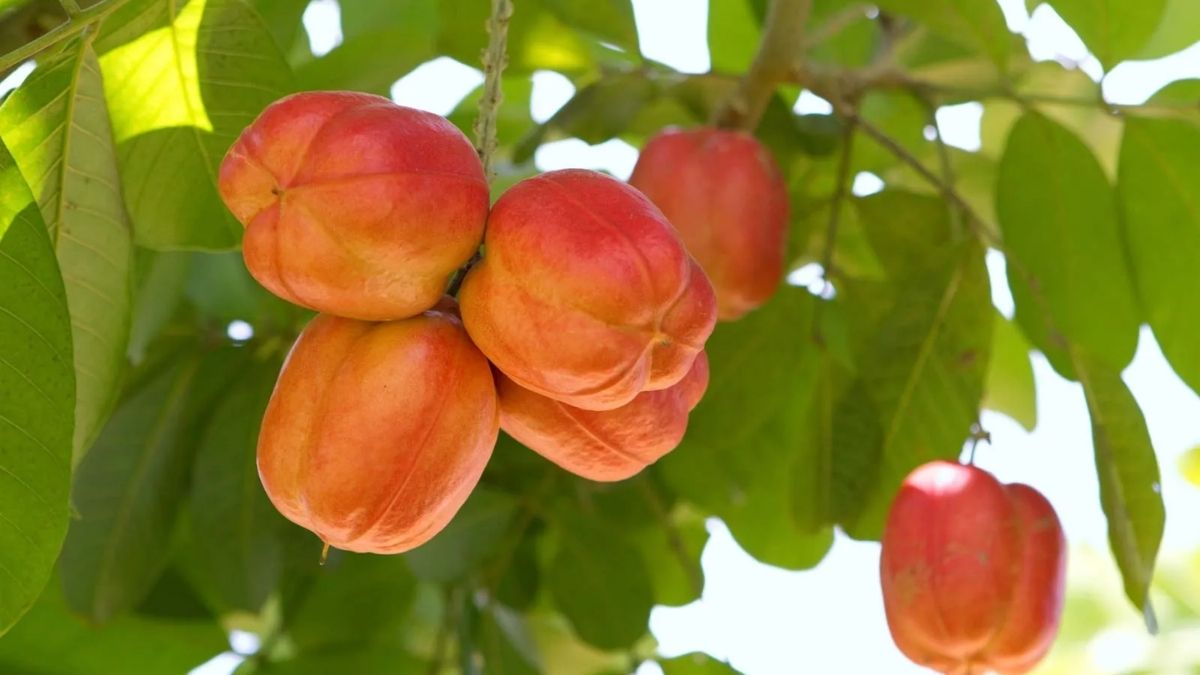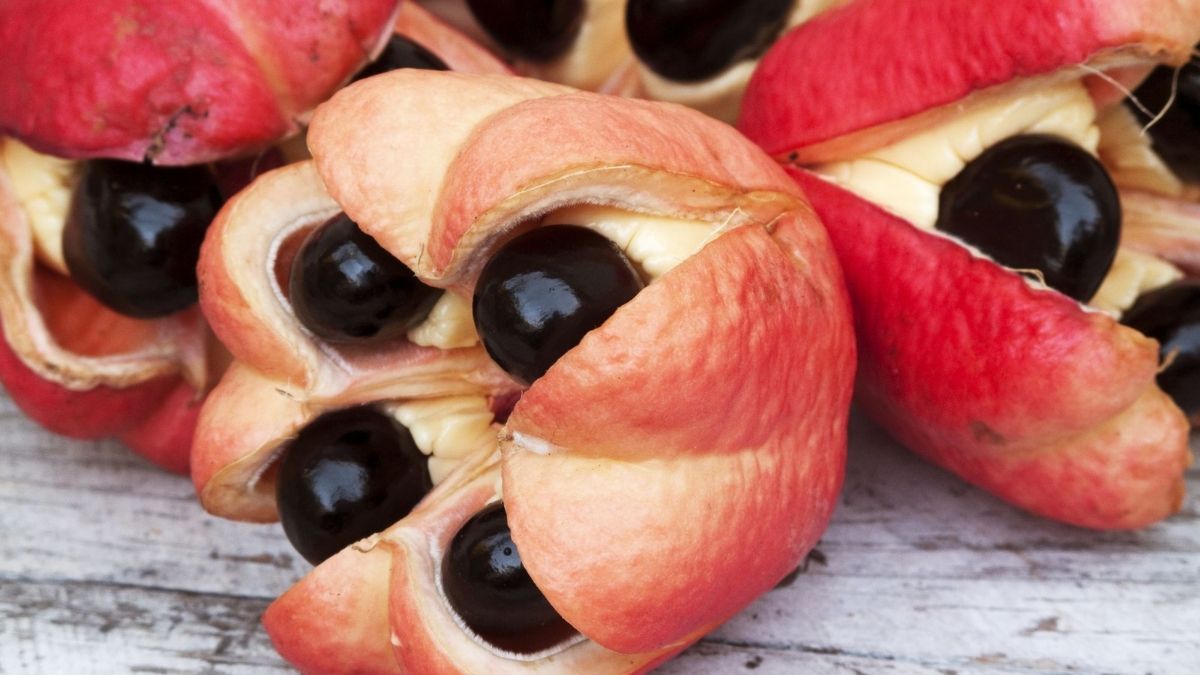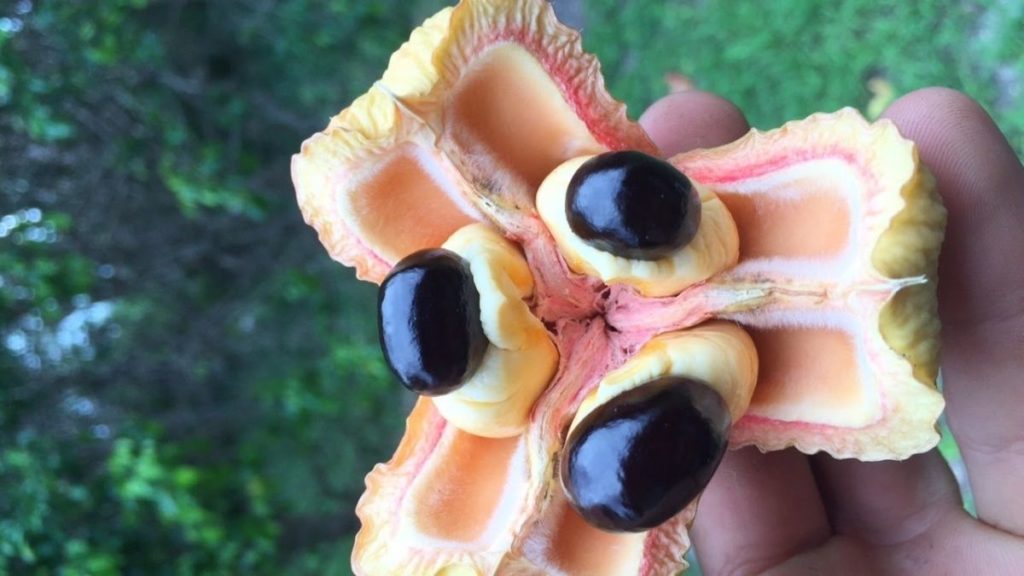Ackee is a colorful and tasty fruit used in many exotic dishes, and it has become a staple in Caribbean food because it tastes good and has health benefits. Scientifically, this fruit is called Blighia sapida.
Although the tomato is used like a vegetable, it’s a fruit, and it’s the same with the ackee. Technically, it’s a fruit, but it’s cooked and used as a vegetable. It’s the national fruit of Jamaica and plays a starring role in the country’s national dish: ackee and saltfish.
What is Ackee Fruit?
It is the national fruit of Jamaica, where it grows in plenty. It comes from a tropical evergreen tree that grows in West Africa. It is also called achee, akee, and ackee apple. Its fruit is fully grown, ready to eat, and can be cooked when the pods are bright red and easily split open to reveal the fruit inside. Jamaicans often say that the fruit will “yawn” or “smile” before it’s ready to be picked from the tree. This means that it will open up on its own.
When the pod opens, three or four cream-colored pieces of flesh called arils are revealed under large, shiny black seeds. What you eat are the arils. Before eating ackee, you have to do a little work, but it’s not hard. Just take out the black seeds and the red lining around each section of flesh. Don’t keep these pieces. You want the flesh itself. Before you cook the meat, rinse it in tap water and let it drain well.
Ackee comes from a tree that stays green all year, and the fruit looks like a pear. It starts green, but as it ripens, it turns yellow, orange, and red, making it easy to recognize. When the fruit splits open, it reveals three big black seeds surrounded by spongy flesh called the aril. This is the part of the fruit that can be eaten. Ackee is best known as the side dish to saltfish and ackee, Jamaica’s national dish and a favorite in almost every shop and street on that Caribbean island.
What are the Health Benefits of Ackee Fruit?
Here are 9 of the many health benefits of this amazing fruit, which contains vitamins, minerals, and other nutrients.
1) Aids Digestion
Ackee fruit has a lot of fiber, which is known to help digestion and has been proven to do so. Dietary fibers speed up the movement of food through the gut by giving it more bulk, making the food particles move more quickly. This helps keep your bowel movements regular and keeps you from getting constipated. Dietary fiber also keeps you from getting bloated and other health problems like irritable bowel syndrome.
2) Regulates Blood Sugar Levels
Because it is high in carbohydrates, ackee is thought to be good for people with type 2 diabetes. It has polysaccharides and complex carbohydrates that break down into energy and control the amount of sugar in the blood. Ackee’s dietary fiber is a polysaccharide that helps control the amount of sugar in the body.
3) Boosts the Immune System
Vitamin C, ascorbic acid, and zinc are the two most important nutrients for a healthy immune system. Both of these nutrients are found in large amounts in ackee. Together, they work to boost our immune system and make our bodies more resistant to sickness. Also, vitamin C is an important part of making collagen, a fibrous protein that the body needs for many different things.
4) Promotes Blood Circulation and Heart Health
Potassium is another thing that is found in ackee fruit in large amounts. We can’t say enough about how good potassium is for our bodies. One of its most important jobs is vasodilation, which is the process of opening up or widening the blood vessels to make it easier for blood to flow through the body. This helps the heart and cardiovascular system work better.
Ackee also has iron, which is important for the health of the heart and blood vessels because it helps carry oxygen to different parts of the body. Together, the two things improve blood flow, lower blood pressure, and lower the risk of diseases like atherosclerosis that can kill. Also, the fruit has unsaturated fats that help keep the heart healthy and lower cholesterol.
5) Supports Muscle Regeneration
Ackee also has iron, which is important for the health of the heart and blood vessels because it helps carry oxygen to different parts of the body. Together, the two things improve blood flow, lower blood pressure, and lower the risk of diseases like atherosclerosis that can kill. Also, the fruit has unsaturated fats that help keep the heart healthy and lower cholesterol.
6) Strengthens Bones
As we get older, our bones lose strength and need extra care. Minerals like iron, zinc, calcium, and phosphorus are found in ackee fruit, and these minerals help our bones stay strong and prevent diseases like osteoporosis and mineral loss. But for this to happen, you need to eat a lot of these minerals, so it’s best to eat ackee and other foods containing them.
7) Prevents Anemia
When our bodies don’t have enough iron, many of their functions get messed up, and in the worst cases, we can get anemia, making us feel weak, dizzy, etc. If you have anemia, it’s probably because you don’t get enough iron from the food you eat. The iron and folic acid in ackee fruit are both important for making healthy red blood cells (RBCs). In addition, the vitamin C in the fruit helps the intestines absorb iron, which lowers the risk of anemia and other similar conditions.
8) Maintains Electrolyte Balance
When our body loses water because of hard physical work or the environment, it throws off the electrolytic balance inside. When this happens, the body’s sodium and potassium levels are also thrown off, which can cause some problems, such as muscle cramps. Both of these things are in ackee. Potassium helps relax the muscles, while sodium helps the muscles contract. Ackee can help stop these effects of dehydration, but drinking water is still the most important thing.
9) Helps with Skin Infections
A study found that extracts from the ackee plant’s leaves and stem bark can help protect the skin from pathogens like Staphylococcus aureus. It also proves that people have always been right to use ackee to treat skin infections.
How to Cook with Ackee?
Most of the time, the fruit is boiled slowly for up to half an hour before it is used in the national dish, ackee and saltfish. When the fruit is ready, it is taken out of the water and sautéed with onions, tomatoes, sweet peppers, allspice, and Scotch bonnet peppers. The mixture is then usually mixed with salt fish. When ackee is done, the flesh will change from a cream color to a bright yellow color. Take it off the heat as soon as it turns yellow to keep it from cooking too much. When ackee is fully cooked, it becomes soft and easy to break or crush.
Salt fish is often served with breadfruit, hard dough bread, dumplings, fried plantains, or green bananas that have been boiled. It is also often served with white rice or rice and peas. Ackee can also be used in soups and desserts such as cakes and custards.
What does Ackee Taste Like?
People who have never been to the Caribbean and don’t know what ackee is often said that it looks like scrambled eggs. This isn’t too far off, but it tastes nothing like scrambled eggs. Even though it has a creamy texture and is soft like eggs, it has a slightly bitter taste at the end. Some people say that when it’s baked, it tastes almost like nuts.
The aril of the Ackee fruit has a mild flavor and feels like butter. Most people like the fruit, but some say that cooked ackee (especially when it’s eaten with saltfish) tastes like scrambled eggs or nuts. It goes well with other foods because of how it looks and tastes. Even though it’s a fruit, it goes well with meat, fish, and vegetables.
Where to Buy Ackee?
Jamaica has many ackee farms, and the country cans and ships the fruit worldwide. You probably won’t be able to find it fresh in the U.S. because the FDA bans the importation of fresh ackee and even a lot of canned ackee unless it has been “green listed,” which means the FDA has checked it and found it to be safe.
This care is needed because unripe ackee, both pods and seeds, can cause Jamaican vomiting sickness because they contain hypoglycin. Hypoglycin is an unnatural amino acid that isn’t destroyed when ackee is canned, and this is why canned ackee is banned in the U.S. Only green ackee knows about this risk. If the pods are bright red and easy to open, they are likely ready and won’t make you sick.
If you can find canned ackee, drain it all the way. It’s already cooked, but most of the time, it’s packed in brine. After you add it to whatever you’re cooking, give the pot one gentle stir, so you don’t break up the meat.
Nutritional Information About Ackee
Jamaicans get a lot of the fatty acids they need from ackee, which has a very high concentration of linoleic acid. Linoleic acid is better than saturated fats and may be good for your heart and blood pressure. Livestrong says that a 3.5-ounce serving of tropical fruit has 151 calories, 9.5 grams of carbs, and 30 milligrams of vitamin C. Ackee also has a lot of niacin, a type of vitamin B3 that may help lower cholesterol.
When you eat ackee, you’ll get a lot of potassium, an important electrolyte that helps control blood pressure and lowers your risk of stroke. According to Healthline, you’ll also get a lot of phosphorus, a mineral that helps your kidneys filter waste and your muscles recover after exercise. And you’ll get a lot of calcium, another important mineral for keeping your bones healthy. Ackee doesn’t have any saturated fat or cholesterol, so it’s Since this ingredient can be used in many different ways, it should be easy to pair it with whatever foods fit your lifestyle.
Conclusion
Ackee that has been canned will last a long time. Fresh ackee can be frozen, but you should blanch it first. When you’re ready to use it, just let it thaw and add it as directed in the recipe. Ackee that has been cooked, like in ackee and saltfish, will keep in the fridge for 3 to 4 days. Ackee that has been canned will last a long time. Fresh ackee can be frozen, but you should blanch it first. When you’re ready to use it, just let it thaw and add it as directed in the recipe. Ackee that has been cooked, like in ackee and saltfish, will keep in the fridge for 3 to 4 days.


